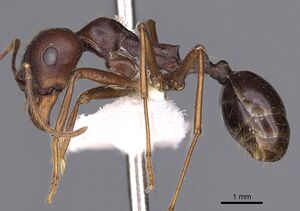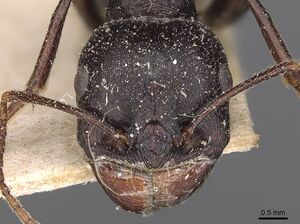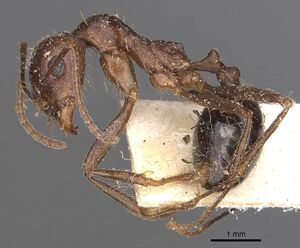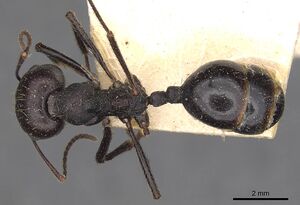Messor denticornis
| Messor denticornis | |
|---|---|

| |
| Scientific classification | |
| Kingdom: | Animalia |
| Phylum: | Arthropoda |
| Class: | Insecta |
| Order: | Hymenoptera |
| Family: | Formicidae |
| Subfamily: | Myrmicinae |
| Tribe: | Stenammini |
| Genus: | Messor |
| Species: | M. denticornis |
| Binomial name | |
| Messor denticornis Forel, 1910 | |
| Synonyms | |
| |
Identification
A distinctive species amongst those with uniformly distributed pilosity on the first gastral tergite, denticornis is immediately isolated by its relatively large eyes. Only a few workers of Messor tropicorum approach even the lower end of its eye size range but in the latter species the clypeus has a conspicuous posteromedian tumulus or welt and the propodeum is shorter and higher in profile than is the case in denticornis. (Bolton 1982)
Keys including this Species
Distribution
Latitudinal Distribution Pattern
Latitudinal Range: -18.95° to -32.53331667°.
| North Temperate |
North Subtropical |
Tropical | South Subtropical |
South Temperate |
- Source: AntMaps
Distribution based on Regional Taxon Lists
Afrotropical Region: Botswana, Namibia (type locality), South Africa.
Distribution based on AntMaps
Distribution based on AntWeb specimens
Check data from AntWeb
Countries Occupied
| Number of countries occupied by this species based on AntWiki Regional Taxon Lists. In general, fewer countries occupied indicates a narrower range, while more countries indicates a more widespread species. |

|
Estimated Abundance
| Relative abundance based on number of AntMaps records per species (this species within the purple bar). Fewer records (to the left) indicates a less abundant/encountered species while more records (to the right) indicates more abundant/encountered species. |

|
Biology
Castes
Worker
Images from AntWeb
   
| |
| Syntype of Messor denticornis. Worker. Specimen code casent0900465. Photographer Ryan Perry, uploaded by California Academy of Sciences. | Owned by NHMUK, London, UK. |
   
| |
| Syntype of Messor denticornis. Worker. Specimen code casent0907746. Photographer Will Ericson, uploaded by California Academy of Sciences. | Owned by MHNG, Geneva, Switzerland. |
   
| |
| Syntype of Messor denticornis brunni. Worker. Specimen code casent0907747. Photographer Will Ericson, uploaded by California Academy of Sciences. | Owned by MHNG, Geneva, Switzerland. |
   
| |
| Syntype of Messor denticornis parvidens. Worker. Specimen code casent0907748. Photographer Will Ericson, uploaded by California Academy of Sciences. | Owned by MHNG, Geneva, Switzerland. |
   
| |
| Syntype of Messor denticornis parvidens. Worker. Specimen code casent0907749. Photographer Will Ericson, uploaded by California Academy of Sciences. | Owned by MHNG, Geneva, Switzerland. |
Nomenclature
The following information is derived from Barry Bolton's Online Catalogue of the Ants of the World.
- denticornis. Messor denticornis Forel, 1910f: 14 (w.q.m.) NAMIBIA.
- Type-material: syntype workers, syntype queens (numbers not stated), 1 syntype male.
- Type-locality: Namibia (“German Southwest Africa”): Lüderitzbucht, 1903 (L. Schultze).
- [Note: Forel records other specimens (not syntypes?) from Namibia: Little Namaland, Kamaggas (L. Schultze), and Little Namaland, Steinkopf (L. Schultze).]
- Type-depositories: BMNH, MHNG.
- Status as species: Arnold, 1920a: 411; Emery, 1921f: 74; Wheeler, W.M. 1922a: 806; Stitz, 1923: 148; Bolton, 1982: 349 (redescription); Marsh, 1986: 341; Bolton, 1995b: 253.
- Senior synonym of brunni: Bolton, 1982: 349; Bolton, 1995b: 253.
- Senior synonym of parvidens: Bolton, 1982: 349; Bolton, 1995b: 253.
- Distribution: Botswana, Namibia, South Africa.
- brunni. Messor denticornis var. brunni Forel, 1910e: 444 (w.) NAMIBIA, SOUTH AFRICA.
- Type-material: syntype workers (number not stated).
- Type-localities: Namibia (“Afrique Sud-Ouest”): (no further data) (Brunn), South Africa: Cape Prov., Steckstown (Wartmann).
- Type-depository: MHNG.
- Subspecies of denticornis: Arnold, 1920a: 413; Emery, 1921f: 74; Wheeler, W.M. 1922a: 806.
- Junior synonym of denticornis: Bolton, 1982: 349; Bolton, 1995b: 253.
- parvidens. Messor denticornis var. parvidens Forel, 1910f: 15 (w.) NAMIBIA, SOUTH AFRICA.
- Type-material: syntype workers (number not stated).
- Type-locality: Namibia (“German Southwest Africa”): Great Namaland, Kubub, 1903 (L. Schultze).
- [Note: Forel records other specimens (not syntypes?) from South Africa: Cape Prov., Steckstown (Wartmann).]
- Type-depository: MHNG.
- Subspecies of denticornis: Arnold, 1920a: 413; Emery, 1921f: 74; Wheeler, W.M. 1922a: 806.
- Junior synonym of denticornis: Bolton, 1982: 349; Bolton, 1995b: 256.
Unless otherwise noted the text for the remainder of this section is reported from the publication that includes the original description.
Description
Worker
Bolton (1982) - Medium to Large, HW 2.48- > 3.10.
Anterior clypeal margin usually evenly convex medially, only rarely with the faintest trace of a central indentation. With the head in full-face view the sides more or less straight and diverging anteriorly, but sometimes the sides more nearly parallel. Occipital margin broadly but shallowly concave, this feature fading out in smaller workers where the margin is approximately transverse. In HW range 2.48-3.16 the maximum diameter of the eye is 0.56-D.70, about 0.21-0.25 x HW, and the CI range is 100-106. Propodeum in profile relatively long and low, resembling that of striatifrons. Propodeal armament very variable, the junction of dorsum and declivity being rounded, acutely angled or distinctly bidentate. These variants are commonly seen in the same series and are in fact shown by the type-series of denticornis itself. Basic sculpture of the head finely densely packed parallel longitudinal rugulae with punctulate ground-sculpture between them. Frequently the sculpture much reduced, either by suppression of the ground-sculpture so that the rugulae stand out from a smooth surface or by reduction of the rugulae in number and intensity so that the head is mostly or wholly punctulate. In smaller individuals the surface may be almost smooth. Dorsal alitrunk rugulose to rugose, the sculpture sometimes partially or totally effaced from the pronotum. First gastral tergite smooth and shining or at most with faint superficial pattering. All dorsal surfaces of head and body with numerous standing hairs. Colour mid-brown to black, sometimes with the gaster darker than the head and alitrunk.
References
- Bolton, B. 1982. Afrotropical species of the myrmecine ant genera Cardiocondyla, Leptothorax, Melissotarsus, Messor and Cataulacus (Formicidae). Bulletin of the British Museum (Natural History). Entomology, 46: 307-370. (page 349, Senior synonym of brunni and parvidens)
- Forel, A. 1910e. Zoologische und anthropologische Ergebnisse einer Forschungsreise im westlichen und zentralen Südafrika ausgeführt in den Jahren 1903-1905 von Dr. Leonhard Schultze. Vierter Band. Systematik und Tiergeographie. D) Formicidae. Denkschr. Med.-Naturwiss. Ges. Jena 16: 1-30 (page 14, worker, queen, male described)
- Gomez, K., Hawkes, P.G., Fisher, B.L. 2023. Ant endemicity in the highlands and escarpments of Angola and Namibia (Hymenoptera, Formicidae). Monograph on Endemism in the Highlands and Escarpments of Angola and Namibia. Namibian Journal of Environment 8, 197-203.
- Jansen, G., Savolainen, R. 2010. Molecular phylogeny of the ant tribe Myrmicini (Hymenoptera: Formicidae). Zoological Journal of the Linnean Society 160(3), 482–495 (doi:10.1111/j.1096-3642.2009.00604.x).
- Ruano, F., Tinaut, A., Soler, J.J. 2000. High surface temperatures select for individual foraging in ants. Behavioral Ecology 11, 396-404.
References based on Global Ant Biodiversity Informatics
- Arnold G. 1920. A monograph of the Formicidae of South Africa. Part IV. Myrmicinae. Annals of the South African Museum. 14: 403-578.
- Bolton B. 1982. Afrotropical species of the myrmicine ant genera Cardiocondyla, Leptothorax, Melissotarsus, Messor and Cataulacus (Formicidae). Bulletin of the British Museum (Natural History). Entomology 45: 307-370.
- Branstetter M. G. 2012. Origin and diversification of the cryptic ant genus Stenamma Westwood (Hymenoptera: Formicidae), inferred from multilocus molecular data, biogeography and natural history. Systematic Entomology 37: 478-496.
- Campbell H., M. D. E. Fellowes, and J. M. Cook. . Species diversity and dominance-richness relationships for ground and arboreal ant (Hymenoptera: Formicidae) assemblages in Namibian desert, saltpan, and savannah. Myrmecological News 21: 37-47.
- Forel A. 1910. Zoologische und anthropologische Ergebnisse einer Forschungsreise im westlichen und zentralen Südafrika ausgeführt in den Jahren 1903-1905 von Dr. Leonhard Schultze. Vierter Band. Systematik und Tiergeographie. D) Formicidae. Denkschriften der Medizinisch-Naturwissenschaftlichen Gesellschaft zu Jena 16: 1-30.
- IZIKO South Africa Museum Collection
- Koch F., and K. Vohland. 2004. Ants along a southern African transect - a basis for biodiversity change monitoring (Insecta, Hymenoptera, Formicidae). Zoosystematics and Evolution 80(2): 261-273.
- Marsh A. C. 1985. Forager abundance and dietary relationships in a Namib Desert ant community. S. Afr. J. Zool. 20: 197-203.
- Marsh A. C. 1986. Ant species richness along a climatic gradient in the Namib Desert. Journal of Arid Environments 11: 235-241.
- Marsh A. C. 1986. Checklist, biological notes and distribution of ants in the central Namib Desert. Madoqua 14: 333-344.
- Robertson H. G. 2000. Formicidae (Hymenoptera: Vespoidea). Cimbebasia Memoir 9: 371-382.
- Wheeler W. M. 1922. Ants of the American Museum Congo expedition. A contribution to the myrmecology of Africa. VIII. A synonymic list of the ants of the Ethiopian region. Bulletin of the American Museum of Natural History 45: 711-1004

